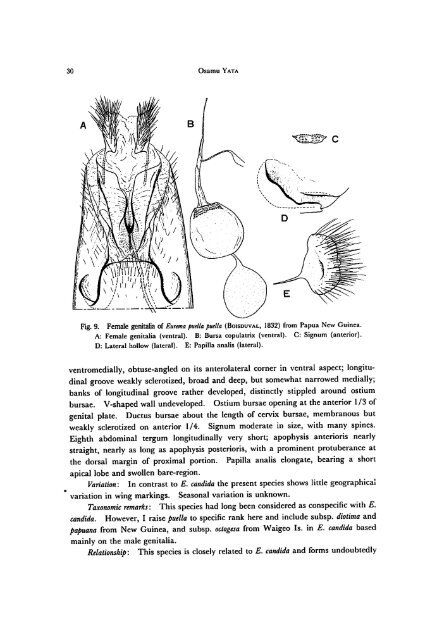A Revision of the Old World Species (Lepidoptera, Pieridae)
A Revision of the Old World Species (Lepidoptera, Pieridae)
A Revision of the Old World Species (Lepidoptera, Pieridae)
Create successful ePaper yourself
Turn your PDF publications into a flip-book with our unique Google optimized e-Paper software.
30 Osamu Yata<br />
Fig. 9. Female genitalia <strong>of</strong> Eurema puella puella (Boisduval, 1832) from Papua New Guinea.<br />
A: Female genitalia (ventral). B: Bursa copulatrix (ventral). C: Signum (anterior).<br />
D: Lateral hollow (lateral). E: Papilla analis (lateral).<br />
ventromedially, obtuse-angled on its anterolateral corner in ventral aspect; longitu<br />
dinal groove weakly sclerotized, broad and deep, but somewhat narrowed medially;<br />
banks <strong>of</strong> longitudinal groove ra<strong>the</strong>r developed, distinctly stippled around ostium<br />
bursae. V-shaped wall undeveloped. Ostium bursae opening at <strong>the</strong> anterior 1/3 <strong>of</strong><br />
genital plate. Ductus bursae about <strong>the</strong> length <strong>of</strong> cervix bursae, membranous but<br />
weakly sclerotized on anterior 1/4. Signum moderate in size, with many spines.<br />
Eighth abdominal tergum longitudinally very short; apophysis anterioris nearly<br />
straight, nearly as long as apophysis posterioris, with a prominent protuberance at<br />
<strong>the</strong> dorsal margin <strong>of</strong> proximal portion. Papilla analis elongate, bearing a short<br />
apical lobe and swollen bare-region.<br />
Variation: In contrast to E. Candida <strong>the</strong> present species shows little geographical<br />
variation in wing markings. Seasonal variation is unknown.<br />
Taxonomic remarks: This species had long been considered as conspecific with E.<br />
Candida. However, I raise puella to specific rank here and include subsp. diotima and<br />
papuana from New Guinea, and subsp. octogesa from Waigeo Is. in E. Candida based<br />
mainly on <strong>the</strong> male genitalia.<br />
Relationship: This species is closely related to E. Candida and forms undoubtedly
















